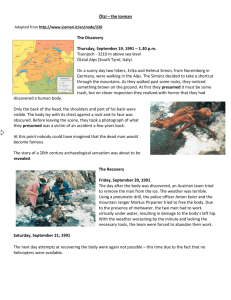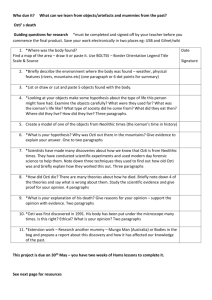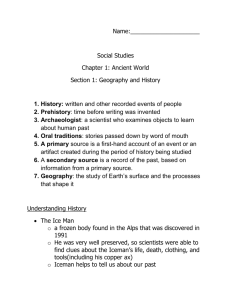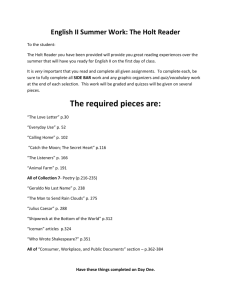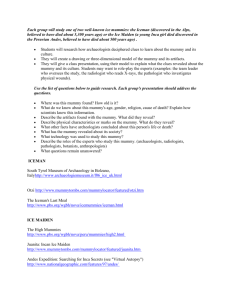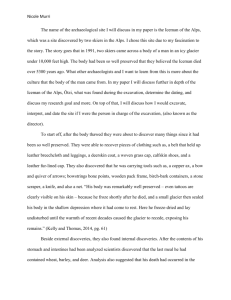The Iceman at the South Tyrol Museum of Archaeology
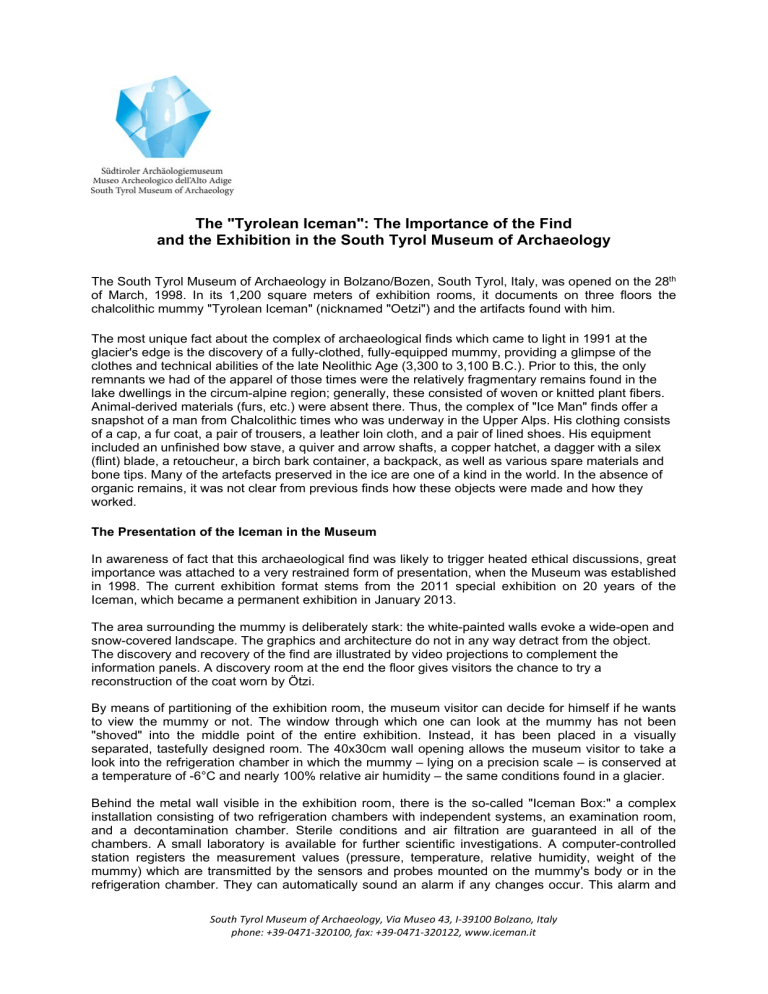
The "Tyrolean Iceman": The Importance of the Find and the Exhibition in the South Tyrol Museum of Archaeology
The South Tyrol Museum of Archaeology in Bolzano/Bozen, South Tyrol, Italy, was opened on the 28 th of March, 1998. In its 1,200 square meters of exhibition rooms, it documents on three floors the chalcolithic mummy "Tyrolean Iceman" (nicknamed "Oetzi") and the artifacts found with him.
The most unique fact about the complex of archaeological finds which came to light in 1991 at the glacier's edge is the discovery of a fully-clothed, fully-equipped mummy, providing a glimpse of the clothes and technical abilities of the late Neolithic Age (3,300 to 3,100 B.C.). Prior to this, the only remnants we had of the apparel of those times were the relatively fragmentary remains found in the lake dwellings in the circum-alpine region; generally, these consisted of woven or knitted plant fibers.
Animal-derived materials (furs, etc.) were absent there. Thus, the complex of "Ice Man" finds offer a snapshot of a man from Chalcolithic times who was underway in the Upper Alps. His clothing consists of a cap, a fur coat, a pair of trousers, a leather loin cloth, and a pair of lined shoes. His equipment included an unfinished bow stave, a quiver and arrow shafts, a copper hatchet, a dagger with a silex
(flint) blade, a retoucheur, a birch bark container, a backpack, as well as various spare materials and bone tips. Many of the artefacts preserved in the ice are one of a kind in the world. In the absence of organic remains, it was not clear from previous finds how these objects were made and how they worked.
The Presentation of the Iceman in the Museum
In awareness of fact that this archaeological find was likely to trigger heated ethical discussions, great importance was attached to a very restrained form of presentation, when the Museum was established in 1998. The current exhibition format stems from the 2011 special exhibition on 20 years of the
Iceman, which became a permanent exhibition in January 2013.
The area surrounding the mummy is deliberately stark: the white-painted walls evoke a wide-open and snow-covered landscape. The graphics and architecture do not in any way detract from the object.
The discovery and recovery of the find are illustrated by video projections to complement the information panels. A discovery room at the end the floor gives visitors the chance to try a reconstruction of the coat worn by Ötzi.
By means of partitioning of the exhibition room, the museum visitor can decide for himself if he wants to view the mummy or not. The window through which one can look at the mummy has not been
"shoved" into the middle point of the entire exhibition. Instead, it has been placed in a visually separated, tastefully designed room. The 40x30cm wall opening allows the museum visitor to take a look into the refrigeration chamber in which the mummy – lying on a precision scale – is conserved at a temperature of -6°C and nearly 100% relative air humidity – the same conditions found in a glacier.
Behind the metal wall visible in the exhibition room, there is the so-called "Iceman Box:" a complex installation consisting of two refrigeration chambers with independent systems, an examination room, and a decontamination chamber. Sterile conditions and air filtration are guaranteed in all of the chambers. A small laboratory is available for further scientific investigations. A computer-controlled station registers the measurement values (pressure, temperature, relative humidity, weight of the mummy) which are transmitted by the sensors and probes mounted on the mummy's body or in the refrigeration chamber. They can automatically sound an alarm if any changes occur. This alarm and
South Tyrol Museum of Archaeology, Via Museo 43, I ‐ 39100 Bolzano, Italy phone: +39 ‐ 0471 ‐ 320100, fax: +39 ‐ 0471 ‐ 320122, www.iceman.it
2 security system enables the museum's own specialized technicians to react immediately in the event of an emergency. The pathologist Dr.med. Eduard Egarter Vigl supervises the preservation of the mummy.
In contrast to the other areas of the museum, the floor dedicated to the Iceman has dimmed lights.
This is not done to create a particular atmosphere, but rather for conservatorial reasons, paying heed to the light-sensitive nature of the objects. The accompanying finds are kept in acclimatised, nitrogenfilled showcases at a temperature of 18°C. The finds are displayed under 50 Lux strong fibre-glass lamps.
The fascination exerted by the world's oldest ice mummy is undiminished even now, more than 20 years after its discovery. But according to the museum visitors, it isn't just the chance for a "face-toface" meeting with an ancient ancestor from the Chalcolithic Period which stamps itself in their memory. More than anything else, it is the equipment – preserved for the first time – of a Chalcolithic man which they find so enthralling: Frozen together with the man, his clothes, tools, and personal effects have withstood the millennia. Carefully restored and reconstructed by the Roman-Germanic
Central Museum in Mainz (Germany), his "thermal shoes," "backpack," and the dagger and sheath make it apparent how expediently equipped the Iceman was. It is amazing to note how little difference there is between the Neolithic implements and the standard equipment of a modern mountaineer. Only the materials have undergone a fundamental modernization. Archaeo-technicians from all over Europe have repeatedly created and tested replicas of the finds discovered along with the Iceman. They were astonished at how functional the bow and arrows were, the hatchet (which could also be used to fell trees), and the tinder polypore from Oetzi's belt, with which he could (together with pyrite nodules) start a fire regardless of wind and weather.
Scientific research
The first finds made it clear that the Iceman – who was, for his era, a relatively old man of approx. 46 years of age – suffered from arthritis. Tattoos applied at certain neuralgic points were intended as a cure. Additionally, he also suffered from intestinal worms.
In 2001, X-ray pictures and CAT scans also revealed the presence of an arrowhead in the Iceman's left shoulder. Since the entry wound didn't have time to heal while he was still alive, and the arrowhead pierced a vital artery, the scientists assume that Oetzi was fatally wounded by an arrow and bled to death within a short time. Additionally, new insights were gained into a cranial injury sustained shortly before his death. These discoveries have done much to illuminate the personal tragedy of the Iceman, but also raise more questions about the cause of his violent death.
In november 2010, twenty years after the mummy's discovery, the Iceman was briefly "thawed out" under controlled conditions by a team of researchers in Bolzano/Bozen in order to extract various tissue samples for further scientific examination. These samples were passed on to independent institutes for analysis. The DNA analysis of the Iceman's stomach contents revealed that the Iceman had eaten venison, forest berries, and einkorn (a natural variety of wheat) – presumably in the form of a mush or bread – a few hours before his death. A meal taken even longer prior to his death contained, among other things, fibers of mountain goat meat which the Iceman may have carried with him in the form of dried or smoked jerky. Further, the examination of the thawed-out body revealed hitherto unnoticed unhealed cuts on his hands indicating that he had been involved in close-quarters fighting shortly before his demise.
On the basis of the mineral composition of the Iceman's teeth, it was possible to define his place of birth. Preliminary results point to two places where the Iceman could have lived on the south side of the Alps: The Eisack Valley and the Vinschgau (while the find was made at the Tisen Ridge).
Important contributions to the scientific research on the Iceman were made by the ‘Institute for
Mummies and the Iceman” at the South Tyrolean research centre EURAC (European Academy), founded in July 2007 and situated in Bolzano/Bozen. The institute is headed by the anthropologist PD
DR. Albert Zink. Website: www.eurac.edu
.
The museum and the Iceman Institute are still receiving numerous research requests per year on the most varied scientific topics and on the basis of which anthropologists and physicians are hoping to attain an even deeper understanding of the development or pathologies of one of our direct ancestors.
South Tyrol Museum of Archaeology, Via Museo 43, I-39100 Bolzano, phone: +39-0471-320100, fax: +39-0471-320122, www.iceman.it

